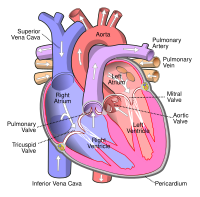
Photo from wikipedia
Abstract To examine the association between patient and hospital characteristics and inferior vena cava filter (IVCF) utilization in patients with venous thromboembolism (VTE). The 2013 to 2014 Nationwide Readmissions Database… Click to show full abstract
Abstract To examine the association between patient and hospital characteristics and inferior vena cava filter (IVCF) utilization in patients with venous thromboembolism (VTE). The 2013 to 2014 Nationwide Readmissions Database was used to define a cohort of patients with VTE aged ≥18 after a primary VTE diagnosis. Comorbidities of interest were classified via diagnosis codes and IVCF placement was identified via procedure code. Chi square analysis tested differences between patient and hospital-level characteristics and whether or not IVCFs were placed. A hierarchical logistic regression model estimated the relationship between patient-level factors (demographics, socioeconomic status, comorbidities), hospital-level factors (bed size, teaching status, urbanity) and whether or not IVCFs were placed. Additional models were specified to examine goodness of fit across methodological alternatives. There were 212,395 VTE hospitalizations, with 12.18% (n = 25,877) receiving IVCF placement. There were significant differences between those who did and did not receive IVCF placement; notably, those receiving IVCFs were older (P < .001), had Medicare insurance more than private (P < .001), longer lengths of stay (P < .001), and were in privately owned hospitals (P < .001). IVCF placement remained significantly associated with patient and hospital-level characteristics following multivariate adjustment via hierarchical logistic regression; notably, age >80 (adjusted Odds Ratio [aOR]: 2.53, 95% confidence interval [CI]: 2.25–2.85), ≥13 comorbid conditions (aOR: 3.85, 95% CI: 3.25–4.27), and privately owned hospitals (aOR: 1.21, 95% CI: 1.08–1.36). Optimal goodness-of-fit was achieved with a combination of random effects and patient-level fixed effects. These findings provide evidence that combinations of patient and hospital-level factors are related to whether patients with VTE receive IVCFs.
Journal Title: Medicine
Year Published: 2018
Link to full text (if available)
Share on Social Media: Sign Up to like & get
recommendations!